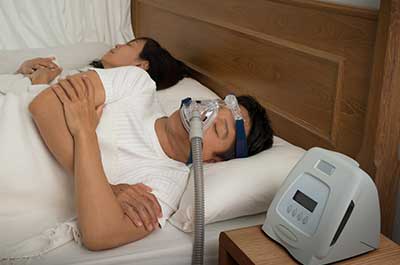Obstructive sleep apnea (OSA) isn’t just a “snoring problem.” It’s a sleep disorder that can cause your blood oxygen levels to drop, which can lead to serious issues like heart disease and diabetes.
Fortunately, OSA is treatable—and for some people, surgery is the treatment of choice. Andrea Plawecki, M.D., an otolaryngologist and sleep medicine specialist at Henry Ford Health, explains OSA surgery and who is a candidate.
What Is Sleep Apnea Surgery?
There is no single surgery to treat obstructive sleep apnea. Instead, your provider will determine the cause of OSA and help you pick the procedure that’s best for you.
“Children with OSA may have enlarged tonsils or adenoids that are blocking their airway,” explains Dr. Plawecki. “The majority of children (and some adults) with this issue benefit from surgical removal of the tonsils or adenoids.”
In most adults, however, there are usually other issues going on, she adds. Adults with OSA may have problems with their tongue or throat muscles. If these structures are enlarged or if they aren’t sitting in the right place, they can block your airway when you sleep.
That’s where OSA surgery comes in. Some people benefit from surgery to remove or reposition excess tissue in the back of the throat, known as uvulopalatopharyngoplasty (UPPP or UP3).
For years, this was the primary option for sleep apnea surgery. Though it worked well for many patients, it involves a longer recovery and can’t be customized or changed once it’s done.

Managing Sleep Apnea
Inspire therapy for sleep apnea
The latest advance in obstructive sleep apnea surgery uses neurostimulation, which doesn’t require cutting or moving muscles in the throat. “Neurostimulation uses gentle electrical impulses to tell your tongue and throat muscles to move forward while you sleep,” explains Dr. Plawecki. “You won’t feel the stimulation during sleep, but your tissues and muscles respond by keeping your airway open.”
Known as Inspire Therapy, this FDA-approved device requires small incisions to place a generator, breathing sensor and the stimulator itself. Like a pacemaker, you can’t see the device once it’s placed in your chest, and no one else will know it’s there. At bedtime, you use a remote control to turn it on and let it do its work.
“This procedure can be life-changing for people with OSA,” says Dr. Plawecki. “It’s also a good long-term solution because we can customize the stimulation if you need stronger or weaker impulses over time.”
Am I a Candidate for Inspire Therapy?
Like any medical treatment, Inspire Therapy isn’t for everyone. You might be eligible for this procedure if:
- CPAP didn’t work for you: Continuous positive airway pressure (CPAP) is usually the first-line treatment for OSA. But in some cases, CPAP doesn’t provide the results you need. “Some people have claustrophobia or other barriers to wearing a CPAP mask at night,” explains Dr. Plawecki. “Other people can’t tolerate the forced air or get irritation on their face from the mask. In most cases, we try CPAP before we discuss surgery because it does work well for many people.”
- You have moderate to severe OSA: Inspire Therapy isn’t for those with mild OSA. “During a sleep study, providers can count how many pauses in breathing you experience per hour,” says Dr. Plawecki. “Generally, people with more than 15 pauses per hour can be candidates for this sleep apnea surgery.”
- Your BMI is under 35: Obesity can make OSA worse, but Inspire Therapy isn’t the first-line treatment in these cases. “Excess weight around the throat may be causing airway blockages,” says Dr. Plawecki. “Weight loss, whether achieved through diet and lifestyle changes, medications or bariatric surgery, is often the best way to treat OSA in people with obesity. Weight loss can also improve your overall health.”
- Your throat has the right structure: The last step before considering Inspire Therapy involves a short procedure to look at your throat. “During this procedure, we put you to sleep and use a thin camera to examine your throat,” says Dr. Plawecki. “We need to see where the airway collapse is happening so we can decide whether the procedure will help you.”
Seek a Solid Sleep Solution
Your sleep is vital to your overall health and well-being, so don’t let sleep apnea slide. “If you’re waking up during the night because of breathing issues or your partner says you’re snoring, tell your provider,” says Dr. Plawecki. “There’s no reason to live with OSA—and the health issues it causes—when we have safe, effective treatments available.”
Reviewed by Andrea Plawecki, M.D., an otolaryngologist and sleep medicine specialist who sees patients at Henry Ford Medical Center - Plymouth, Templin and New Center One.



